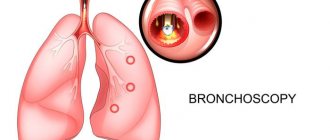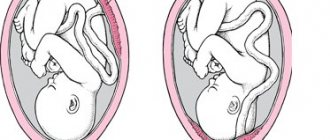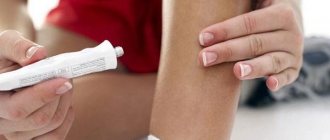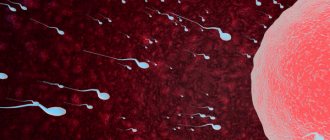The first month after an abortion, it is especially important to pay increased attention to your health, because this determines not only how quickly the recovery period will pass and whether there will be complications, but also whether the body will restore regenerative function at all.
In order to “not be excruciatingly painful” later, it is important to take this stage of life after an abortion responsibly, follow doctors’ recommendations and be more careful with yourself during this period.
Abortion methods
Today there are three known ways to remove the fertilized egg from the uterine cavity:
- medicinal;
- mini-abortion;
- surgery.
The first one feels quite uncomfortable, but at the same time it is as gentle as possible. The essence of this method is to artificially simulate a miscarriage. Until a certain period (20 days from the moment of conception), the embryo does not yet have time to attach securely to the uterine cavity. In fact, there is no child at this stage; there is a fertilized egg located in the body. Its development is supported by a certain hormonal background of a woman. Forcibly blocking the corresponding substances leads to miscarriage. Recovery occurs over several months. But it often happens that physiologically a woman returns to normal even faster. Mini-abortion using modern equipment can be performed for up to 7 weeks. Using an aspirator, negative pressure is created inside, thanks to which the embryo is simply sucked out.
Minimal blood loss, absence of physical damage to the cervix, small amount of time required for the manipulation itself are positive aspects. All this becomes the reason that a woman, when turning to qualified specialists, receives less damage than during a surgical operation. But the period is later than the one at which a medical abortion occurs, and the nature of the intervention still requires at least two months for recovery. If after termination of pregnancy an inflammatory process begins or complications arise, this period increases.
Surgical intervention is carried out up to 12 weeks, according to Russian legislation, at the request of the woman. The procedure itself involves artificial dilatation of the cervix and curettage of the cavity with a sharp curette. Recovery depends both on the woman’s condition and on the doctor’s experience, since inept actions can lead to perforation of the uterus. Rehabilitation in this case will require a long time, since the internal genital organs were damaged. The average period is about six months.
How to prepare for the procedure?
In order for curettage to take place without unpleasant complications from the gastrointestinal tract, you should not eat 12 hours before the operation (especially if it is performed under general anesthesia). You should also empty your bowels and bladder immediately before the procedure, perform a cleansing enema at home, and carefully shave your pubic and perineal hair.
To perform curettage, you will need a consultation with an anesthesiologist and a number of tests and studies:
1. Gynecological examination. 2. Smear for oncocytology. 3. Smears for infectious diseases of the genital area to exclude infection of the appendages during surgery. 4. Ultrasound of the uterus to determine the gestational age and the nature of the location of the fertilized egg. 5. Tests for HIV, hepatitis B, C, syphilis. If STI pathogens are detected in smears, a course of intensive therapy is carried out before the abortion to eliminate the disease.
Possible complications
Various complications delay the recovery process. Sometimes medical abortion or even vacuum aspiration does not bring the desired result: the embryo or its parts remain in the uterus. In this case, curettage is required, which in itself is traumatic in such a situation. The exact recovery time is predicted by the doctor treating and monitoring the patient. But often even an experienced gynecologist can only offer to monitor the condition, prescribe stimulants and restorative drugs. But if the doctor’s inept actions led to additional complications. Let's say the patient did not follow the prescribed recommendations: she visited the bathhouse, began to be sexually active prematurely, and suffered from excessive stress. Then further rehabilitation will most likely occur in the hospital, under medical supervision.
Abortion after childbirth
Abortion after childbirth also has its own specifics. Recovery is more difficult, largely because the body will most likely lose additional blood, and the cardiovascular system would not be worth stressing with anesthesia. However, the desire to endure pain will also hit the body, so doctors in such a situation are forced to offer the patient to choose the lesser of two evils. That is why obstetricians and gynecologists strongly recommend that young mothers use condoms when resuming sexual activity. To obtain greater guarantees, you can combine the barrier method with oral contraceptives.
Repeated abortion
Recovery after a repeat abortion slows down noticeably. The exact timing here depends on the general condition of the body, the ability to regenerate, and the woman’s age. With a good initial immune status, the return to normal occurs somewhat faster than might be expected. But you shouldn’t rely too much on the body’s potential to calmly endure peculiar experiments on itself. A woman can get sick, and during this period she is threatened by pathologies associated not only with the reproductive system. Quite often chronic diseases begin to intensify.
Psychological rehabilitation
Among other things, do not forget about the importance of psychological recovery.
It is more difficult to make predictions here than in the case of physiology; each case is individual. Much depends on a woman’s upbringing; religion also plays an important role. The manifestation of reactions varies, some are deeply depressed, others go into a defensive position, and others ignore what happened to them. Some patients perceive what happened as murder. But even those who do not consider the fetus a child cannot rid themselves of the thought of negligence in relation to their own body. A separate conversation concerns women who were forced to have an abortion for medical reasons, but wanted to keep the child. Often the subsequent period is accompanied by severe depression. Relatives do not always notice the signs of this disease quickly enough, before it becomes severe. In any case, doctors strongly recommend visiting a psychotherapist. Even if psychological recovery after an abortion occurs normally, it is advisable to verify this with the help of a specialist.
The Importance of the Abstinence Period
After an abortion, a woman’s body undergoes a number of physiological and physical changes:
- a sharp imbalance occurs in the hormones responsible for the emergence of sexual desire - estrogen and progesterone;
- follicle-stimulating hormone is not produced;
- after an abortion, a depressed psychological state is observed;
- bloody discharge persists in the area of the external genitalia for a long time;
- mechanical impact on the cervix is painful;
- Displacement and vibration of the pelvic organs also causes pain.
During this period, it is better not to insist on natural coitus, but to make do with alternative methods of sexual stimulation of a woman.
Stages of recovery
To avoid dangerous consequences after an abortion, the patient must abstain from intimate sex for 4-5 weeks. Deviation from this recommendation is fraught with complications.
- The body is especially vulnerable after the curettage procedure. Intimacy during such an unfavorable period can lead to severe bleeding and rejection of particles of the uterine mucosa. Such troubles occur due to infection in the injured uterine body.
- It is highly recommended not to lift heavy objects. You should also not take a bath or swim in an open pond or swimming pool. This is a direct route to contracting a dangerous infection. It is better to postpone such water procedures until better times.
- After the stressful situation of having an abortion procedure, it is important to eat well. The diet should consist of fresh vegetables and fruits, fish, lean meats, nuts, and dairy products. Protein and fiber are the basis for proper menu construction. Healthy food helps speed up the rehabilitation period and will return lost strength.
- You also need to listen to yourself and not ignore any suspicious symptoms. These include: fever, excessive bleeding, chills, severe weakness, persistent aching pain. Sports lovers should take care. It is forbidden to visit the gym for a month. The body is significantly weakened, the abdominal muscles need rest and time for complete recovery.
- Drinking any alcoholic beverages is strictly contraindicated. Especially in the case of drug therapy. At the slightest pathological manifestations, you should urgently seek medical help.
Uterine body
The uterus is an organ that is seriously affected during the abortion procedure.
The longer the gestation period, the more damage to the uterus. Curettage has the most negative impact on the condition of the organ. After removal of the fertilized egg, the uterine body slowly contracts. Gradually, over the course of several days, it acquires its original size. The endometrial layer is damaged, the uterine walls are injured. It takes time for everything to heal and return to generally accepted norms. It is believed that the condition of the uterus is completely restored within 4-5 weeks. When the menstrual cycle resumes, it functions normally again. The internal mucous membrane of the organ also meets the parameters. After one or two weeks, a visit to your attending gynecologist is required. Inspection is very important. If there is copious discharge mixed with blood and mucus, then an inflammatory process is occurring. It is possible that fetal particles remained in the uterine body after cleaning. Therefore, to avoid misunderstandings, an ultrasound is always performed. Based on its results, the doctor determines whether there are abnormal abnormalities and the cleanliness of the uterus. Then he prescribes restorative procedures.
Sexual relations
Sexual contact is the next thing you should not do after cleaning the uterus. The duration of abstinence is determined by the gynecologist individually in each case after examining the patient. The duration of uterine recovery depends on the cause of curettage and the general health of the woman. In the vast majority of cases, the recovery period lasts 1 menstrual cycle.
You can have sex after curettage no earlier than 2 weeks later. This is the minimum period during which the uterine mucosa is completely replaced after cleaning. It is advisable to use a condom and avoid casual sexual intercourse.
If the endometrium has not yet fully recovered, the risk of infection increases significantly. There are many diseases that occur in a latent form and do not pose a danger to a healthy body. But as a result of weakened immune defenses, the likelihood of infection and the spread of the disease increases significantly.
There is also a risk of damage to the vaginal walls, which can increase the severity of bleeding. And this is another reason why you should not have sex after cleansing.
After the start of sexual activity, a woman may feel slight pain, burning and dryness in the vagina. There is no need to do anything, since such symptoms are considered normal and go away on their own.
If the discomfort does not go away, then you need to consult a gynecologist. After a vaginal examination and based on the results of a transvaginal ultrasound examination, appropriate treatment will be prescribed.
Menses
How to recover faster after an abortion, what should you do first? These questions concern every woman who has undergone a procedure to get rid of the fetus. A period of time is required for normal processes to resume. For example, it takes about a month for menstruation to occur. The same time is required to restore the uterine body and endometrial layer. After an abortion, the functioning of the hormonal system is disrupted. Stops producing both luteinizing hormone and stimulating follicle production. It is impossible to determine exactly when menstruation will resume. Each case is individual, it all depends on a combination of factors. On average, the menstrual cycle resumes a month after the intervention. In case of surgical curettage, recovery will take a little longer. Particular attention should be paid to the nature of the discharge over several months. The cycle may become longer.
- Excessively heavy and prolonged periods after an abortion are an alarming sign.
- Too scanty menstruation is also a pathology. It is better to consult your attending gynecologist.
- There are several reasons for weak discharge. Starting from hormonal imbalance, endometrial damage and ending with problems with the pituitary gland.
- In most cases, these are the consequences of a pill abortion.
- If your periods are scanty or too heavy, you should urgently visit a doctor. He will give you a referral for a medical examination. Then he will individually select a therapeutic method.
Nature and quantity of discharge
The first periods after curettage come according to the usual schedule and have the same characteristics:
- natural shade;
- normal amount;
- usual duration;
- minor pain.
Modification of monthly bleeding is allowed only for the better. After all, the purpose of cleaning or scraping is aimed at eliminating disorders of the reproductive system. Therefore, women who are accustomed to heavy or long periods mistake positive changes in the cycle for pathology.
Menstrual flow as a result of curettage can:
- maintain your usual volume;
- become meager;
- increase your number;
- develop into bleeding.
In a normal situation, the change in the amount of discharge is positive due to the elimination of a negative factor (disease). You should be alarmed by spotting on the pad or heavy bleeding.
Do I need to protect myself?
What to do, how to restore the body after an abortion?
As already mentioned, the main rule is complete abstinence from sex for at least 4-5 weeks. After the patient can be sexually active, contraception should be used. This is necessary, since ovulation often occurs in the first cycle after an abortion. A woman needs to protect herself from unwanted conception. In the first months after the procedure, the body is weakened. The rehabilitation period lasts at least six months. If you shorten the recommended period, there is a high risk of pathologies occurring during pregnancy. Taking oral contraceptives is an excellent solution to the problem at this stage. Birth control pills have a positive effect on the hormonal system. They also prevent possible neuroendocrine disorders. Self-administration of any medications is unacceptable. Even if the patient had previously taken a certain type of pill. The doctor prescribes birth control pills that contain little hormones. This is due to hypercoagulation in several cycles. Estrogen hormones have the ability to increase blood clotting. The drugs are taken on the day of abortion. Tablets such as Regulon, Mercilon, etc. are prescribed. The day of administration is considered the day the new cycle begins.
What factors influence rapid recovery?
Abortion is a serious intervention in a woman's body. As after any operation, it takes time for the reproductive system to fully recover. To do this, you need to strictly follow a special scheme developed by your gynecologist. Many people underestimate the danger of the abortion procedure. After termination of pregnancy, you must be under medical supervision. This is mandatory, this way you can prevent an undesirable turn of events. It is no secret that after an abortion there are often complications that negatively affect life in the future. You cannot ignore persistent aching pain in the lower abdomen, excessive discharge with blood clots, etc. The fact of excessive delay in menstruation should alert you. Any pathology should not be ignored. A timely visit to the doctor will speed up recovery after an abortion. He will determine the cause of your poor health and select the appropriate treatment.
The duration of rehabilitation depends on the presence of chronic diseases in the patient. Heredity also plays an important role. It is important to consider exactly what method was used to remove the fertilized egg. With mini-abortion or vacuum aspiration, a relatively quick recovery is observed. And with medical or surgical curettage, rehabilitation after an abortion is delayed.
The fact is that the gestation period is also important during the procedure. If conception was interrupted at the very beginning of gestation, this will not have much effect on the body. Of course, you should go to a good clinic. Much depends on the degree of qualification of the operating doctor and on the effectiveness of the prescribed physiotherapy. It is not easy to decide to have an abortion, so you need to psychologically prepare yourself in advance. Age category is an important aspect. Rehabilitation for a young girl will be easier than for an adult woman. But youth is not a guarantee that infertility problems will not arise in the future.
Why does my stomach hurt after an abortion?
In principle, aching pain in the lower abdomen after the procedure is considered normal. Usually this condition lasts 5-7 days. If the pain causes severe torment that is difficult to endure, immediately consult a gynecologist. Such complications do not arise out of the blue; there are reasons.
- Persistent pain accompanied by an increase in temperature is a reason to be wary. This is how the onset of inflammation, which arose against the background of a latent infection, makes itself felt.
- If during the first 2-3 days the temperature remains at 37.5 and does not decrease, this is very dangerous. You need to seek medical help as soon as possible.
- Pain similar to contractions is a sign of hematometra formation. Or they say that embryonic particles remain in the uterus.
To avoid the development of inflammatory processes after an abortion, a course of antibiotics is prescribed. This is a prerequisite for prevention for those who previously had not very good smear, blood, etc. indicators.
How is curettage performed?
[ads1]Before surgery, a vaginal examination is performed to accurately determine the position, size and shape of the uterus.
You will also need to consult an anesthesiologist to find out contraindications to anesthesia and select its method. Most often, the patient is given instant intravenous anesthesia directly on the operating table, having previously installed a catheter for the possible addition of a portion of the drug during manipulation. In rare cases, abortion is performed using spinal anesthesia or endotracheal anesthesia.
Expert advice
Recovery after a miscarriage plays a key role in the future.
If the patient follows all the recommendations, this is a big plus for the reproductive system. It is important at first to protect yourself from hypothermia, do not sit in the cold, do not walk in the rain. Complete rest will help you gain strength. A balanced diet will restore your energy. You should take a shower several times a day to avoid bacterial infection. Hot baths are strictly contraindicated; they can cause bleeding. Don't forget to change sanitary pads every 2-3 hours. Since bloody discharge, when it solidifies, is a source of infection. Tampons are strictly prohibited. Their use can cause an acute inflammatory process in the uterine cavity and other dangerous pathologies. It's better to put tampons aside until better times. It is necessary to strictly follow all the advice of doctors and gradually recover.










